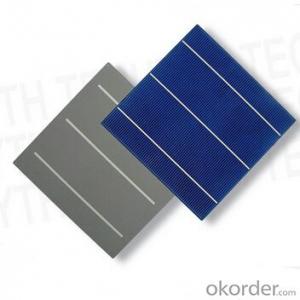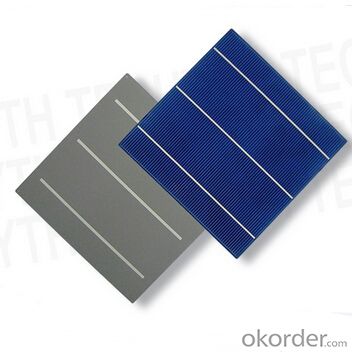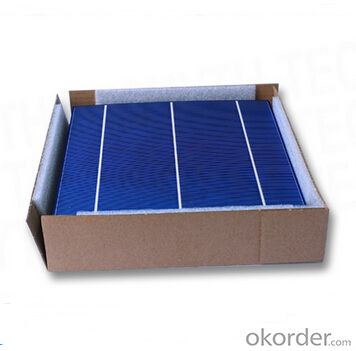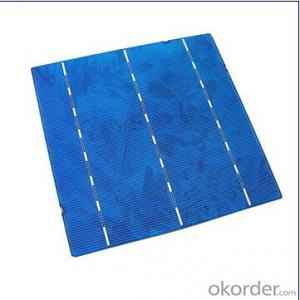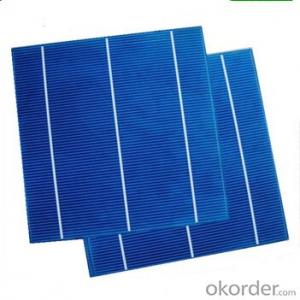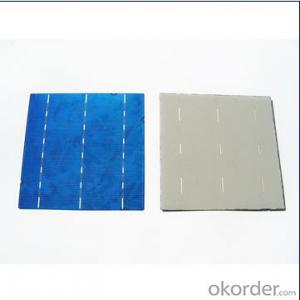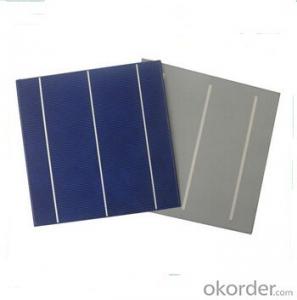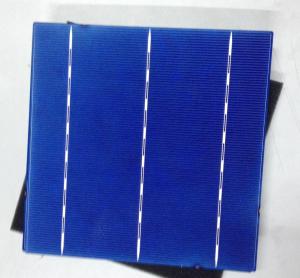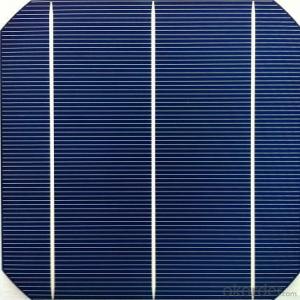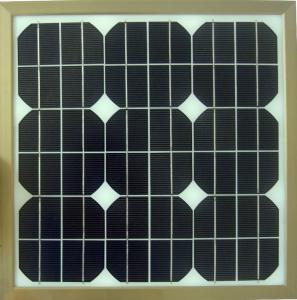Indoor Polycrystalline Solar Cells Series - C-16.80%
- Loading Port:
- Shanghai
- Payment Terms:
- TT OR LC
- Min Order Qty:
- 3000 pc
- Supply Capability:
- 300000 pc/month
OKorder Service Pledge
OKorder Financial Service
You Might Also Like
Solar Cells:
Solar cells is made by solar wafer, it has three categories of solar cell right now, monocrystalline polycrystalline and thin film,These cells are entirely based around the concept PN junction, which is the critical part of solar module, it is the part that can convert the light energy into electricity, the thickness is from 180um to 200um, with even busbars to conduct electricity, textured cell can decrease diffuse reflection; they are often electrically connected and encapsulated as a module. Photovoltaic modules often have a sheet of glass on the front (sun up) side, allowing light to pass while protecting semiconductor wafers from abrasion and impact due to wind-driven debris, rain, hail, etc. Solar cells are also usually connected in series in modules, creating an additive voltage. Connecting cells in parallel will yield a higher current;With high quality and stable quality. Our Cells can greatly improve the performance of Solar Modules.
Features:
1. High conversion efficiencies resulting in superior power output performance.
2. Outstanding power output even in low light or high temperature conditions
3. Optimized design for ease of soldering and lamination
4. Long-term stability, reliability and performance
5. Low breakage rate
Solar Cells Advantage:
• High efficiency and stable performance in photovoltaic conversion.
• Advanced diffusion technique ensuring the homogeneity of energy conversion efficiency of the cell.
• Advanced PECVD film forming, providing a dark blue silicon nitride anti-reflection film of homogenous color and attractive appearance.
• High quality metal paste for back surface and electrode, ensuring good conductivity, high pulling strength and ease of soldering.
• High precision patterning using screen printing, ensuring accurate busbar location for ease with automatic soldering a laser cutting.
Specifications:
Kit content:
Product: multicrystalline cell based on poly silicone
Format: 156 x 156mm ± 0.5mm
Front contacts (-): 3*1.5mm wide bus bars (silver), acid texturized surface, blue silicone nitride antireflection coating
Back contacts (+): 3*3mm wide bus bars (silver/aluminum), aluminum backside metallization
Warranty:
Repairs: For repairs please contact to us
Exchange service: You can choose between a refund, exchange or credit where goods are faulty or doesn’t do what it’s supposed to do
| Model | C16.80% |
| Max power | 2W |
| Short-circuit current (Isc) | 4.205A |
| Imax at 0.5V | 4A |
| Open circuit voltage (Voc) | 0.62V |
| Size | 156*78mm |
| Efficiency | 16.80% |
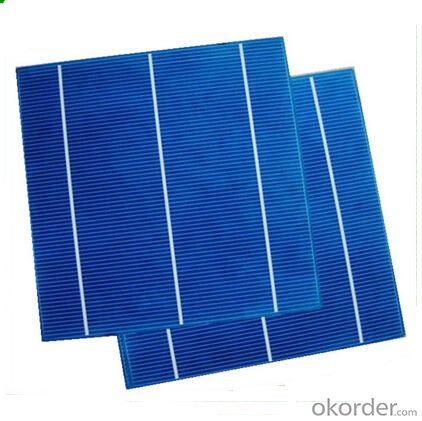
FAQ
We have organized several common questions for our clients,may help you sincerely:
1. What’s price per watt?
A: It’s depends on the quantity, delivery date and payment terms of the order. We can talk further about the detail price issue. Our products is high quality with lower price level.
2. Can you tell me the parameter of your solar cells?
We have different series of cells with different power output, both from c-si to a-si. Please take our specification sheet for your reference.
3. How do you pack your products?
We have rich experience on how to pack the panels to make sure the safety on shipment when it arrives at the destination.
4. Can you do OEM for us?
Yes, we can.
5. How long can we receive the product after purchase?
In the purchase of product within three working days, We will arrange the factory delivery as soon as possible. The perfect time of receiving is related to the state and position of customers. Commonly 7 to 10 working days can be served.
- Q: What is the impact of extreme temperature fluctuations on solar cell efficiency?
- Extreme temperature fluctuations can have a significant negative impact on solar cell efficiency. High temperatures can cause the cells to overheat, leading to a decrease in their performance and efficiency. On the other hand, very low temperatures can also reduce their efficiency as the cells become less effective at converting sunlight into electricity. Therefore, it is crucial to consider temperature management in solar installations to optimize their efficiency and overall performance.
- Q: What is the role of solar cells in powering remote surveillance systems?
- Solar cells play a crucial role in powering remote surveillance systems by harnessing the sun's energy and converting it into electricity. This renewable energy source allows surveillance systems to operate in remote locations without relying on traditional power grids or expensive fuel sources. Solar cells provide a sustainable and reliable power supply, ensuring continuous operation of surveillance equipment, including cameras, sensors, and communication devices, even in areas without access to electricity.
- Q: Can solar cells be used in agriculture for irrigation?
- Yes, solar cells can be used in agriculture for irrigation. Solar-powered water pumps can be used to draw water from wells or other sources, providing a reliable and sustainable solution for irrigation. This helps farmers reduce their dependence on traditional energy sources and decrease operational costs, making solar cells a viable option for agricultural irrigation.
- Q: What is the role of solar cells in powering streetlights?
- The role of solar cells in powering streetlights is to capture sunlight and convert it into electricity, which is then stored in batteries. This stored energy is used to power the streetlights during the night, reducing the dependence on the electrical grid and minimizing energy costs and environmental impact.
- Q: What is the environmental impact of solar cells?
- Solar cells have a relatively low environmental impact compared to other forms of energy generation. While their production does require the extraction and processing of raw materials, such as silicon and metals, the overall energy and resource requirements are relatively low. Furthermore, solar cells generate electricity without emitting greenhouse gases or other pollutants during operation, reducing air and water pollution. Although their end-of-life disposal can pose some environmental challenges, proper recycling and waste management can minimize these impacts. Overall, the environmental benefits of solar cells, including reduced carbon emissions and resource conservation, outweigh their limited environmental footprint.
- Q: Can solar cells work in cloudy weather?
- Yes, solar cells can still generate electricity in cloudy weather, although their efficiency may be reduced. Cloud cover reduces the amount of direct sunlight reaching the solar panels, resulting in lower power output compared to sunny conditions. However, modern solar technologies, such as thin-film solar cells, are capable of generating electricity even in low-light conditions, making them suitable for use in areas with frequent cloud cover.
- Q: Can solar cells be used for portable devices?
- Yes, solar cells can be used for portable devices. Advances in technology have made it possible to miniaturize solar cells, making them suitable for powering various portable devices such as smartphones, tablets, and even wearable electronics. These devices can be charged directly from sunlight or through the use of portable solar panels, offering a sustainable and renewable source of power on the go.
- Q: What is the role of solar cells in powering water pumping systems?
- Solar cells play a crucial role in powering water pumping systems by converting sunlight into electricity, which is then used to run the pumps. This renewable energy source eliminates the need for traditional fuel sources and provides a sustainable and cost-effective solution, especially in remote or off-grid areas where access to electricity is limited.
- Q: Can solar cells be used in parking lots?
- Yes, solar cells can be used in parking lots. They can be installed on canopies or shade structures above parking spaces, or integrated into the ground as solar parking lot tiles. This allows parking lots to generate clean and renewable energy while providing shade for vehicles.
- Q: Can solar cells be used for water heating?
- Yes, solar cells can be used for water heating. Solar thermal systems use solar energy to heat water directly, while solar photovoltaic systems can generate electricity to power water heaters. Both methods are efficient and environmentally friendly alternatives to traditional water heating systems.
Send your message to us
Indoor Polycrystalline Solar Cells Series - C-16.80%
- Loading Port:
- Shanghai
- Payment Terms:
- TT OR LC
- Min Order Qty:
- 3000 pc
- Supply Capability:
- 300000 pc/month
OKorder Service Pledge
OKorder Financial Service
Similar products
Hot products
Hot Searches
Related keywords
